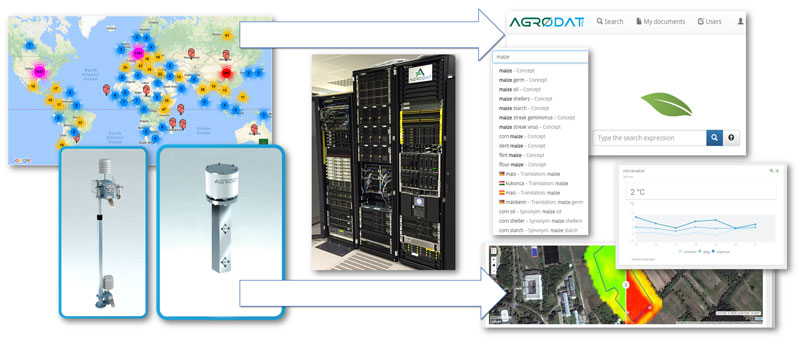by Róbert Lovas (MTA SZTAKI), Krisztián Koplányi (eNET) and Gábor Élő (Széchenyi István University)
Since 2014 the Agrodat project and its collaborating partners have been working on introducing new, cost-effective sensor technologies and advanced ICT solutions for the Hungarian agriculture sector. Currently, 50 farmers and other targeted user communities have access to data analytics services with automatic warnings in case of hazardous conditions.
Agricultural production always bears a high degree of uncertainty because yield can fluctuate significantly depending on weather conditions, pests, irrigation and fertilisation, but the market and political factors also considerably influence the profitability of farming. With the help of precision farming, as a special method of crop management, many production factors can be precisely tracked, thereby reducing the risk. Additionally, the cost of producing the crop and the environmental impacts might be significantly reduced, since this new approach enables farmers to make decisions about variables such as: which areas of land/crop within a field can be managed with reduced levels of fertiliser, chemicals, and irrigation water, depending on particular factors, like the yield potential of the crop in the given area.
In general, to implement precision farming and related methods, a vast amount of data about the cultivated fields must be collected from various sources, and analysed. Nationwide projects, such as Agrodat from Hungary, require even more sophisticated IoT and big data solutions starting from the sensor level, through to the applied communication network, and ending with the advanced data analytics facilities and knowledge centre.
The AgroDat project [L1] (launched in January 2014) is a collaboration between HP Enterprise, eNET Internet Research and Consulting Ltd., Institute of Computer Science and Control of the Hungarian Academy of Sciences (MTA SZTAKI), and Széchenyi István University. The project’s aim was to create a knowledge centre for precision agriculture based on both local sensor data and semi- or unstructured data from international repositories.

Figure 1: High-level concept of Agrodat: data sources + Big Data centre + decision support system with knowledge base/multilingual search engine.
By December 2017, at the end of the project, nearly 1,000 complex sensor pillars were deployed at selected locations covering more than 3,000 hectares on the properties of 50 farmers in Hungary. The sensor pillars, which we developed, have a modular structure and are equipped with anti-theft solutions (GPS, tilt sensor) as well as facilities to measure: wind speed and direction; precipitation; air temperature (at 20cm/2m) and relative humidity; solar radiation and reflection; leaf wetness; and soil moisture, temperature and conductivity at various levels. The IoT communication network is based on the 4G mobile network, and M2M communication enabled SIM cards. [1]
In order to provide an experimental platform for developers, researchers, and other involved parties, a new big data centre was established in 2015 and operated by MTA SZTAKI with hierarchical storage and advanced databases (e.g., Cassandra and HPE Vertica); GPGPU cluster for processing raw data; Apache Hadoop and Spark clusters for analytics, etc.
An OpenStack on-premise cloud is responsible for providing an elastic and flexible framework for the research platform to facilitate the development of higher-level new software layers including the cloud orchestrator tool for complex services based on Occopus [2], the IoT back-end for data collection [3], the Flowbster [4] cloud-oriented workflow system to process large scientific data sets , and the various modules of decision support / visualisation systems.
The aggregation of related scientific and other semi- or non-structured data from international repositories leverages partly on the experiences gained during the elaboration of the integrated workflow-oriented services in the former EU FP7 agINFRA project. The new Agrodat search tool, on the one hand, takes the advantage of the HPE IDOL (Intelligent Data Operating Layer) enterprise search engine that offers advanced functionalities for conceptual and contextual analysis of such structured, semi-structured and unstructured data. On the other hand, the new tool integrates the AGROVOC multilingual agricultural thesaurus that consists of over 34,000 concepts available in 29 languages and published by the Food and Agriculture Organisation. In this way, the tool enables data managers, researchers, and the broader user community to access dozens of international repositories (registered in the CIARD RING, http://ring.ciard.net) and also to use them for data exploration and analytical purposes. As one of the latest developments, the Agrodat platform is able to calculate and visualise NDVI (Normalised Difference Vegetation Index) from Sentinel 2 multispectral images.
The targeted end-users include farmers, experts, service companies in the agriculture sector, insurance companies, universities and research communities. The most welcome functionalities of the decision support system by the farmers are the visualisation of the collected data and the automatic issuing of various pest control warnings in case of special weather conditions that make it possible for the farmers to intervene (e.g. preventive steps) in a timely and targeted fashion, which increases the expected crop yield.
Link:
[L1] www.agrodat.hu
References:
[1] G. Paller, P. Szármes, G. Élő: “Power Consumption Considerations of GSM-connected Sensors in the AgroDat.hu Sensor Network”, Sensors and Transducers, 189:6 (2015)
[2] J. Kovács, P. Kacsuk: “Occopus: a Multi-Cloud Orchestrator to Deploy and Manage Complex Scientific Infrastructures”, Journal of Grid Computing, 16:1 (2018)
[3] A. Csaba Marosi, A. Farkas, R. Lovas: “An adaptive cloud-based IoT back-end architecture and its applications”, PDP 2018 conference (2018)
[4] P. Kacsuk, J. Kovács, Z. Farkas: “The Flowbster Cloud-Oriented Workflow System to Process Large Scientific Data Sets”, Journal of Grid Computing, 16:1 (2018)
Please contact:
Zsolt Büki, eNET Ltd., Hungary
+36 30 902 8846










